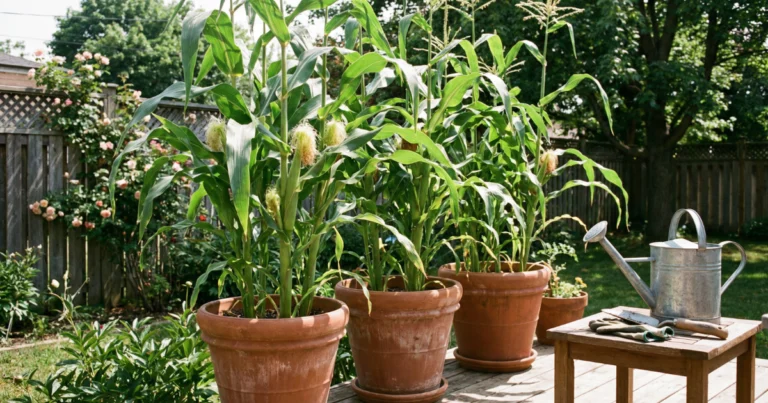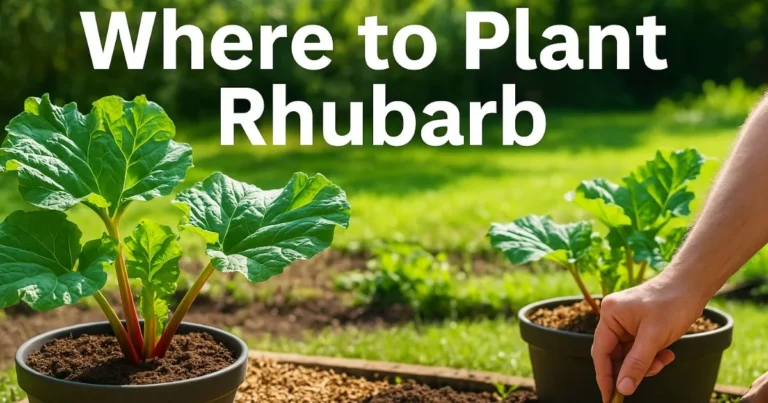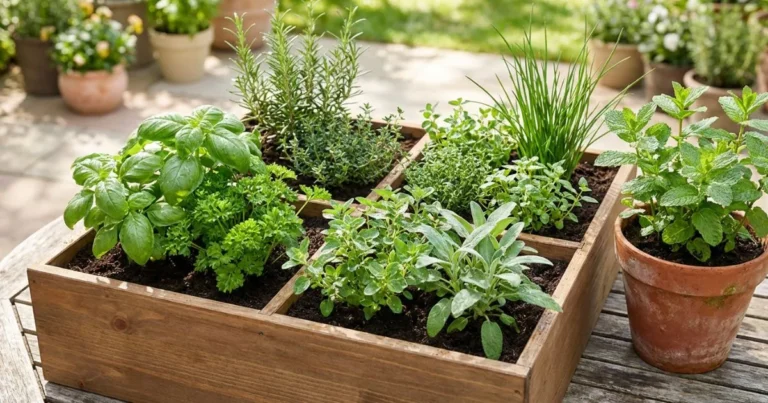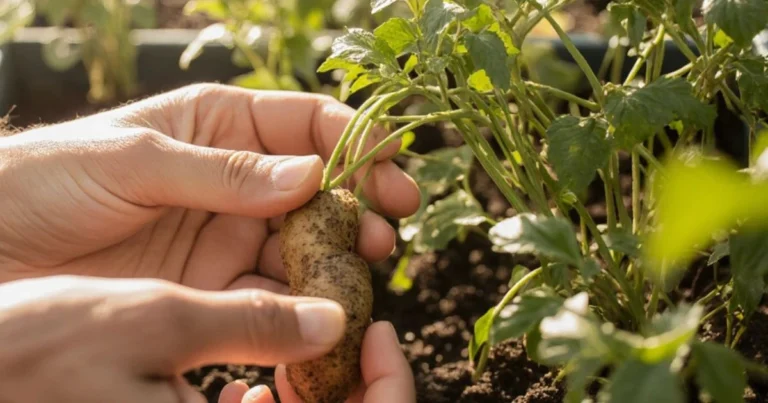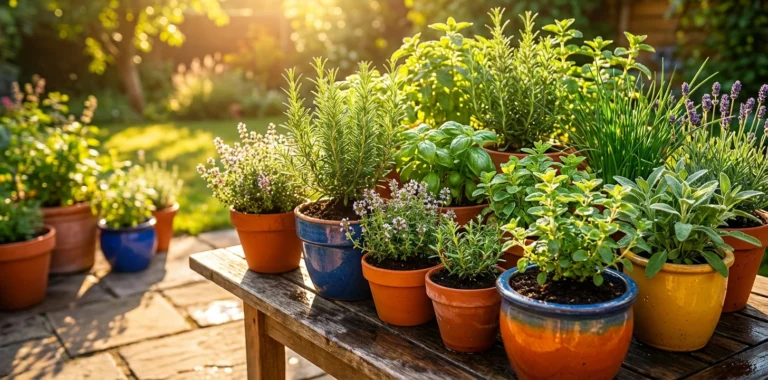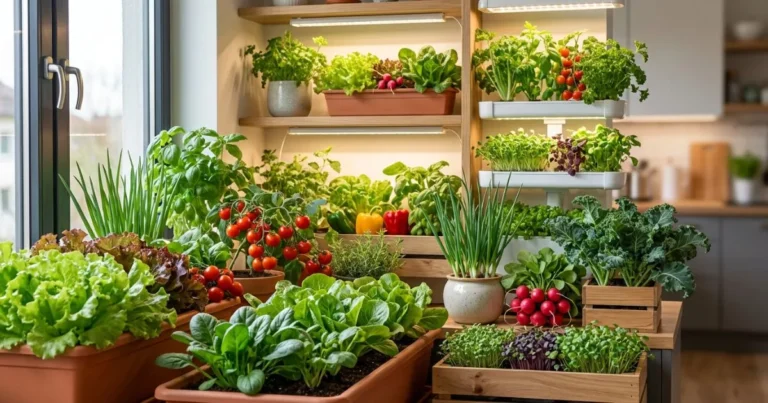Growing Rhubarb in Pots: Tips for Success
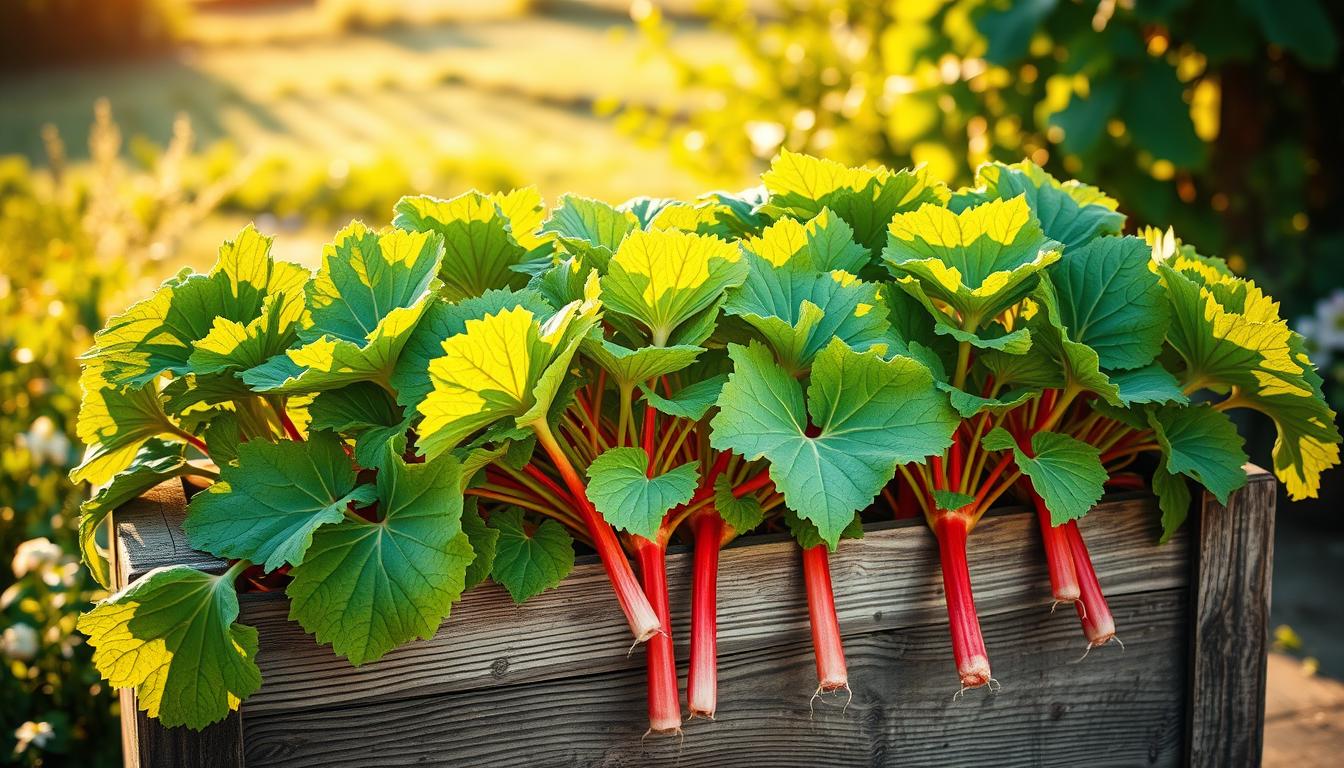
Table of Contents
Growing Rhubarb in Pots: Tips for Success
Are you looking to add a versatile and hardy perennial to your garden, but limited by space or poor native soil? Container gardening can be the perfect solution. Rhubarb is an excellent choice for container gardening, offering a unique opportunity to cultivate this perennial in small gardens.
Container gardening rhubarb allows you to control the soil quality and provide the necessary conditions for optimal growth. With the right tips and advice, you can successfully grow rhubarb in pots and enjoy its benefits.
By following the right guidelines, you can overcome the challenges associated with growing rhubarb and enjoy a bountiful harvest. In this article, we will explore the key considerations for successful container gardening with rhubarb.
Why Grow Rhubarb in Containers?
Container gardening for rhubarb is great for those with little space. It lets you grow rhubarb even without a big garden.
Benefits of Container Gardening for Rhubarb
There are many good things about growing rhubarb in containers. Container gardening lets you control the soil quality and drainage. These are key for rhubarb to grow well.
Mobility and Flexibility
Container gardening is also very flexible. You can move your rhubarb plants to get the best sunlight and temperature. This flexibility ensures optimal growing conditions for your rhubarb.
Control Over Growing Conditions
Containers let you control your rhubarb’s growing conditions. You can pick the best soil mix and make sure your plants get the right moisture and nutrients.
Space-Saving Solution for Small Gardens
For those with small gardens, growing rhubarb in containers is perfect. It lets you grow this perennial vegetable without using up too much space. You can put the containers on balconies, patios, or even indoors, as long as they get enough light.
Choosing the Right Rhubarb Varieties for Containers
To grow rhubarb in pots, pick a variety that does well in containers. Some rhubarbs grow better in pots because they are more compact.
Compact Varieties That Thrive in Pots
Some rhubarbs grow smaller and produce fewer stalks, perfect for pots. Victoria and Timperley Early are great examples.
Victoria and Timperley Early
Victoria grows fast and has tart stalks. Timperley Early starts producing stalks in March. Both are good for pots because they are smaller.
Cherry Red and Valentine
Cherry Red and Valentine have beautiful stalks and grow compactly. Cherry Red has bright red stalks, adding color to your garden.
Popular Rhubarb Cultivars for Container Growing
When picking rhubarb for containers, think about their growth. Some rhubarbs can get big, so choose varieties that fit in small spaces.
Growth Habits to Consider
| Variety | Growth Habit | Stalk Color |
|---|---|---|
| Victoria | Vigorous, Compact | Green with Red Flush |
| Timperley Early | Early Producer, Compact | Green |
| Cherry Red | Compact | Bright Red |
| Valentine | Compact, Attractive Stalks | Red |
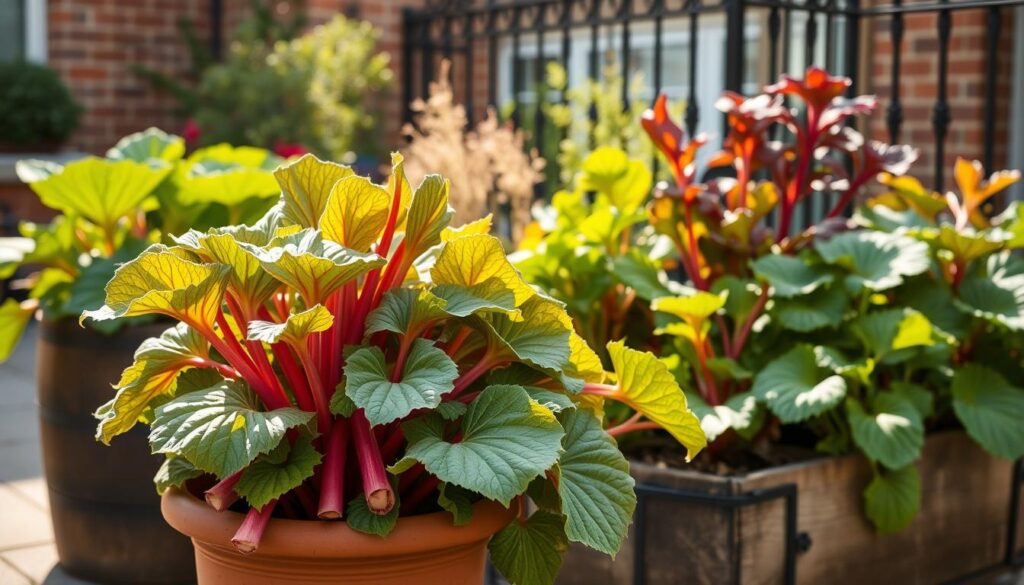
By picking the right variety, you can get a lot of tasty rhubarb from your containers.
Selecting the Perfect Container for Growing Rhubarb
Growing rhubarb in containers needs careful thought. You must consider the pot’s size, material, and drainage. The right container supports healthy growth and a good harvest.
Size and Depth Requirements
Rhubarb plants have a big root system. So, the container must be deep enough. A depth of 18-24 inches is best for root growth.
Minimum Dimensions for Healthy Growth
Choose a container that fits the plant’s mature size. A small pot can limit growth and yield. Look for a pot with a diameter of at least 24 inches for enough space.
Material Considerations: Plastic vs. Terracotta vs. Fabric
The container’s material affects your rhubarb’s health. Here are some points to consider:
- Plastic Containers: They are light, easy to clean, and keep moisture well. But, they’re not as durable.
- Terracotta Containers: They breathe, look natural, and are pleasing. But, they’re heavy and dry out easily.
- Fabric Containers: They drain well, are flexible, and help roots grow. But, they’re not as pretty as others.
Pros and Cons of Each Material
Think about each material’s pros and cons. For example, terracotta pots might need more water in hot climates.
Drainage Essentials
Good drainage is key to avoid waterlogged soil. This prevents root rot. Make sure your container has enough holes for water to drain.
The Best Soil Mix for Potted Rhubarb
Choosing the right soil mix is key for growing healthy rhubarb in pots. Rhubarb likes soil that drains well and is fertile. It also prefers a slightly acidic to neutral pH.
Soil Composition and pH Requirements
Rhubarb does best in soil rich in organic matter and good drainage. The best mix includes loam, compost, and aged manure. These provide the nutrients it needs.
Ideal pH Range for Rhubarb
The pH level of the soil is very important for rhubarb. It should be slightly acidic to neutral, between 6.0 and 7.0. Keeping this pH range helps it absorb nutrients well and grow healthy.
Creating a Nutrient-Rich Growing Medium
To make a nutrient-rich soil for your potted rhubarb, add compost and organic matter. Compost helps keep moisture, fights diseases, and gives essential nutrients.
Compost and Organic Matter Ratios
Start with 20-30% compost in your potting soil. You can adjust this based on your rhubarb’s needs and the soil’s condition. Adding aged manure also boosts soil fertility.
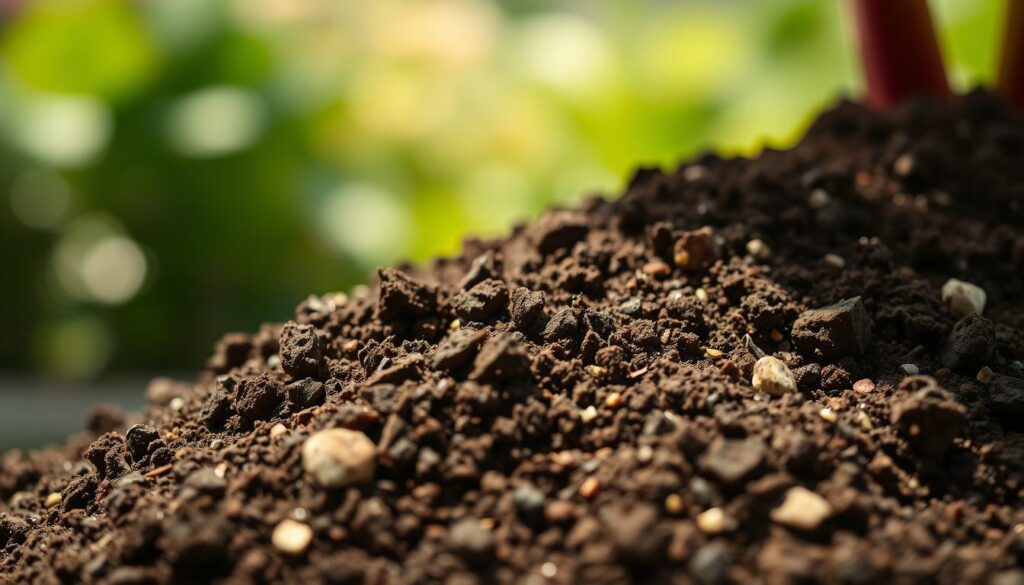
By focusing on these key elements, you can make a soil mix that supports your potted rhubarb’s growth. This ensures a good harvest.
When and How to Plant Rhubarb in Pots
To grow rhubarb in containers, you need to know when and how to plant it. You can plant rhubarb in pots in the spring or fall. You can use either crowns or seeds.
Starting from Crowns vs. Seeds
Choosing between crowns and seeds has its pros and cons. Crowns give you a head start, leading to a harvest in about a year. Seeds are cheaper and can be started indoors, but they take longer to grow.
Pros and Cons of Each Method
Starting with crowns is usually best for a quick harvest. But, seeds can be a fun challenge or a way to grow new plants.
Planting Depth and Spacing
For crowns, plant them in a container that’s 12-18 inches deep. Make sure the crown bud is up and 1-2 inches below the soil. For seeds, plant them 1/4 inch deep and 1-2 inches apart.
Seasonal Timing for Planting
The best time to plant rhubarb varies by region. Spring and fall are usually the best times. Spring planting helps the plant grow before summer heat. Fall planting gives it a head start for the next year.
Regional Considerations
In cold areas, plant in the spring after the last frost. In milder climates, fall planting works well. It lets the rhubarb grow over winter.
Growing Rhubarb in Pots: Essential Care Tips
Rhubarb in pots needs special care to grow well. This includes the right amount of water and food. Knowing what it needs is crucial for its health.
Watering Requirements
Rhubarb needs steady moisture, more so in hot weather. Check the soil often. Water when the top inch feels dry.
Signs of Under and Overwatering
Too little water makes leaves wilt and stalks hard. Too much water causes root rot. Look for yellow leaves if it’s too wet.
Fertilizing Schedule
Use a balanced fertilizer in spring for growth. You can pick organic or synthetic, based on your gardening style.
Organic vs. Synthetic Options
Organic fertilizers like compost feed slowly and enrich the soil. Synthetic fertilizers give quick nutrients but can harm soil if used too much.
Mulching for Moisture Retention
Mulching keeps moisture in, stops weeds, and controls soil temperature. Use organic mulch like straw or bark chips.
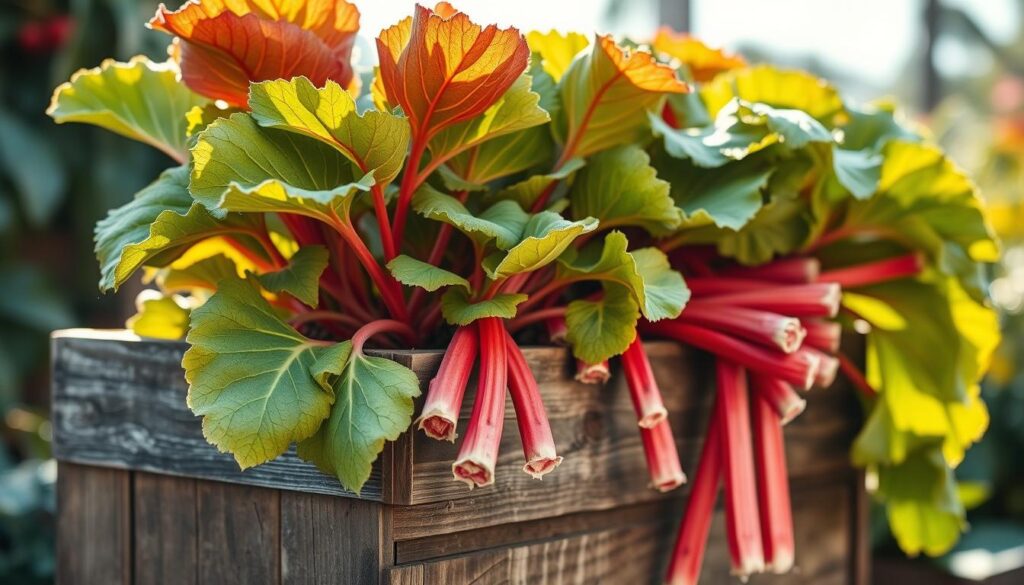
Follow these tips for a great rhubarb harvest from pots. Consistent care is essential for growing rhubarb in containers.
Managing Potted Rhubarb Through the Seasons
As the seasons change, your potted rhubarb needs special care to grow well. Knowing what it needs at different times is key for its health and growth.
Spring and Summer Care
In spring and summer, your rhubarb needs lots of water and food. Make sure the soil is always moist but not too wet. Fertilize your rhubarb with a balanced fertilizer to help it grow strong. Watch out for pests and diseases that can harm your plant.
Fall Preparation
When fall comes, get your rhubarb ready for the cold. Water it less as it grows slower. Cut off any dead stalks to keep it looking good and healthy.
Winter Protection Strategies
Keeping your rhubarb safe from extreme cold is very important. If it’s very cold where you live, move the pot to a warmer place or cover it with mulch or straw.
Cold Climate Considerations
In really cold places, you might need to do more to protect your rhubarb. You can wrap the pot in burlap or a frost blanket to keep it warm.
Mild Climate Adjustments
In milder climates, your rhubarb might not need as much protection. Just keep an eye on the temperature and adjust your care as needed.
By changing how you care for your rhubarb with the seasons, it will stay healthy and grow well every year.
Dividing and Repotting Container Rhubarb
To keep your rhubarb thriving in containers, you need to divide and repot it regularly. Rhubarb plants should be divided every 3-4 years. This is because their crowns grow too big for the container.
When to Divide Rhubarb Plants
The best time to divide rhubarb is in early spring or fall. This is when the plant is dormant. It helps the plant adjust better before it starts growing again.
Step-by-Step Division Process
To divide your rhubarb, start by carefully removing it from its container. Then, gently separate the crowns. Make sure each section has at least one ‘eye’ or bud.
Replant the divisions in a new container filled with a well-draining soil mix. Water them thoroughly.
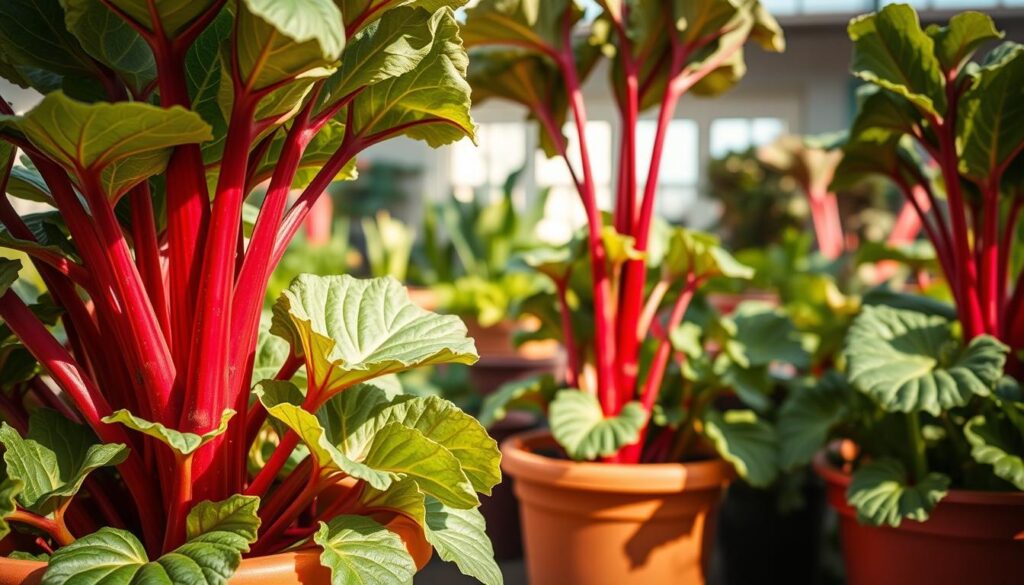
Post-Division Care
After dividing and repotting, make sure your rhubarb gets enough care for potted rhubarb. This includes watering and fertilizing it well. Mulching around the plants helps keep moisture in and weeds out.
By following these tips for potting rhubarb, you can keep your rhubarb plants healthy and productive in containers.
Indoor Rhubarb Container Gardening
You can grow rhubarb in pots indoors with the right care. It needs careful planning and attention to thrive. This is because rhubarb has specific needs that must be met.
Light and Temperature Requirements
Rhubarb needs lots of light to grow well indoors. It should be in a spot with plenty of natural light. But, if it’s winter or the room is dark, you might need extra light.
Supplemental Lighting Options
LED grow lights are great for rhubarb. They’re energy-saving and have the right spectrum for plants. Just make sure they’re not too close to the leaves.
Forcing Rhubarb Indoors
Forcing rhubarb means changing its growing conditions to get stalks out of season. You can control temperature and light to do this.
Creating Off-Season Harvests
To force rhubarb, move the crowns to a warm, dark spot. Then, slowly add light and keep the temperature steady. This way, you can get rhubarb stalks even when it’s not the right time.
| Condition | Requirement | Benefit |
|---|---|---|
| Light | Plenty of natural or supplemental light | Promotes healthy growth |
| Temperature | Consistent, avoiding extremes | Encourages steady development |
| Forcing | Controlled temperature and light | Allows for off-season harvests |
Troubleshooting Common Problems with Potted Rhubarb
When you care for your potted rhubarb, you might face some common issues. These can include pests or poor stalk growth. Understanding the causes and finding solutions is key.
Identifying and Treating Pests
Pests like aphids, slugs, and others can harm potted rhubarb. It’s important to spot these problems early and act fast.
Aphids, Slugs, and Other Common Pests
To fight aphids, use neem oil or insecticidal soap. Slugs can be kept away with copper tape or crushed eggshells. Keeping your garden clean and checking your plants often can also help.
Disease Prevention and Management
Diseases like crown rot and fungi can harm potted rhubarb. Good air flow, removing sick leaves, and fungicides can help manage these issues.
Crown Rot and Fungal Issues
To avoid crown rot, don’t overwater and make sure the pot drains well. For fungal problems, remove sick leaves and apply fungicide.
Addressing Growth Issues
Leggy growth and weak stalks can be due to too little light, not enough nutrients, or bad watering. Changing how you care for your rhubarb can fix these problems.
Leggy Growth and Poor Stalk Development
For healthy stalks, make sure your rhubarb gets enough light and nutrients. Regular fertilizing and proper watering can stop leggy growth.
Harvesting Rhubarb from Containers
Spring brings the moment of truth when you can harvest rhubarb from your containers. This task is both simple and rewarding. Rhubarb stalks are ready when they’re 12-18 inches long.
When to Harvest
The best time to pick rhubarb is in the spring, usually late March or early April. Your climate might vary. It’s key to wait until the stalks are the right size for tenderness and flavor.
First-Year Considerations
In the first year, harvest rhubarb lightly. This helps the plant build a strong root system. This way, you’ll get more rhubarb in future years.
Proper Harvesting Techniques
There are two ways to harvest rhubarb: twisting or cutting. Both work well, but each has its own benefits.
Twist vs. Cut Methods
- Twist Method: Hold the stalk firmly at the base and twist it away. This method is gentle on the crown.
- Cut Method: Use a sharp knife or garden shears to cut the stalk at the base. It’s faster but needs more care to avoid damage.
Maximizing Your Yield
To get the most rhubarb, make sure your container gets enough sunlight, water, and nutrients. Check your plants often for pests or diseases. Act quickly if you find any.
Conclusion
You now know how to grow rhubarb in pots and enjoy a big harvest. By following the tips in this article, you can grow rhubarb in small spaces too.
Choosing the right rhubarb variety and the best container are key. Also, using the right soil mix is important. Regular care like watering, fertilizing, and mulching will help your rhubarb grow well. With these tips, you’ll soon have a delicious harvest.
Keep watching your plants and change your care as needed. With practice and patience, you’ll get good at growing rhubarb in pots. You’ll enjoy all the benefits it brings.

